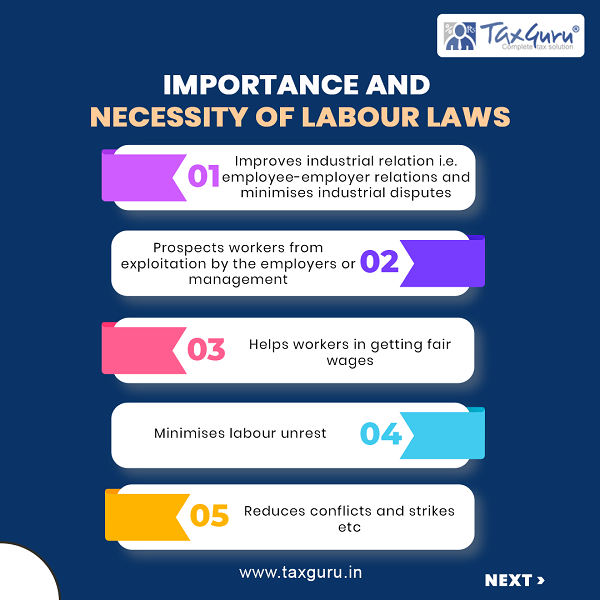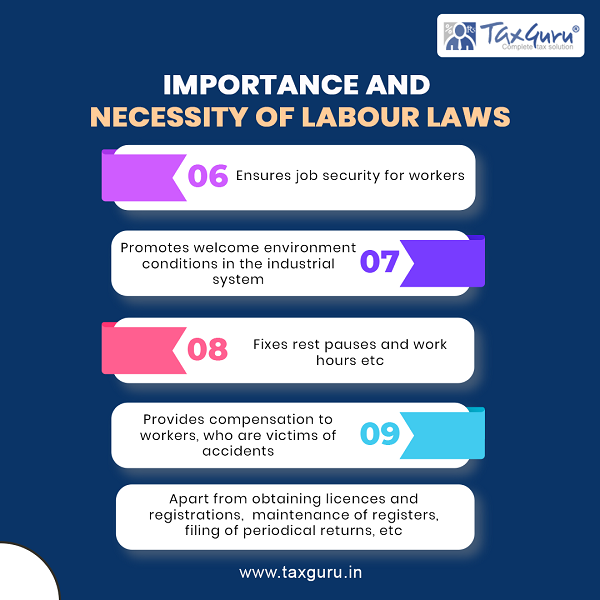Labour laws Compliance & Checklist
Labour laws or labour legislations is the body of laws, administrative rulings, precedents which address the relationship between and among the employers, employees and labour organisations, often dealing with the issues of public law. Indian labour law refers to laws regulating labour in India.
Traditionally, Indian governments at federal and state level have sought to ensure a high degree of protection for workers, but in practice, legislative rights only cover a minority of workers. India is a federal form of government and because labour is a subject in the concurrent list of the Indian Constitution, labour matters are in the jurisdiction of both central and state governments; both central and state governments have enacted laws on labour relations and employment issues. In India there is no single code on the labour and employment laws covering all aspects of labour and employment related matters.
Both the Central and the State Governments have the power to legislate on the subject of employment and labour relations. In addition to the Central enactments, each State Government has enacted State-specific legislations and further rules pursuant to the Central legislations leading to complexities. In order to provide clarity and to boost ease of doing business, major labour law reforms are planned by the Indian Government.
IMPORTANCE AND NECESSITY OF LABOUR LAWS
(1) Improves industrial relation i.e. employee-employer relations and minimises industrial disputes.
(2) Prospects workers from exploitation by the employers or management
(3) Helps workers in getting fair wages
(4) Minimises labour unrest
(5) Reduces conflicts and strikes etc.
(6) Ensures job security for workers
(7) Promotes welcome environment conditions in the industrial system
(8) Fixes rest pauses and work hours etc.
(9) Provides compensation to workers, who are victims of accidents.
Apart from obtaining licences and registrations, maintenance of registers, filing of periodical returns, etc. under the applicable labour and employment legislations, the employers in India are also obligated to undertake the following to comply with statutory provisions:
COMPLIANCES UNDER LABOUR AND EMPLOYMENT LEGISLATIONS:-
- Provide a safe working environment at the workplace which includes safety from persons coming into contact at the workplace
- Formulate clear rules or policies against sexual harassment
- Constitution of ICC (in case the number of employees working in the organization are not less than 10) under the provisions of the Sexual Harassment for Women at Workplace
- To ensure that employees work in safe, healthy and sanitary conditions.
- The employers should provide facilities such as rest rooms, first aid appliances and so on to workers employed
- Provide a safe working environment at the workplace which includes safety from persons coming into contact at the workplace
- Formulate clear rules or policies against sexual harassment
- Conduct workshops and awareness programmes
- Drafting and implementation of data protection policy
- Drafting and implementation of equal opportunity policy
- Display of abstracts of Payment of Gratuity Act and Maternity Benefit Act


CHECKLIST OF LABOUR LAW COMPLIANCE :-
A compliance checklist is exactly what it sounds like – a detailed cognitive and comprehensive list used to aid in the completion of a procedure or task. It is essentially a guide to make sure that everything is running smoothly. Statutory compliance under various labour laws has to be ensured by establishments. A detailed checklist to check compliance of labour laws is given hereunder:-
COMPLIANCE REQUIREMENT-
1. FACTORIES ACT , 1948 –
Licensing and renewal of licence under the Act.
- Provision of adequate safety measures within the factory premises.
- Provision of adequate welfare measures like creche, canteen, wash room etc for the workers.
- Payment of wages as per the provisions of the Act.
- Payment of overtime wages.
- Maintenance of registers.
- Submission of returns.
2. WORKMEN’S COMPENSATION ACT , 1923-
- Provision of compensation in case of accident.
- Submission of returns as stipulated under the Act
3. APPRENTICES ACT , 1961 –
- Appointment of apprentices if the company falls under the notified industry.
- Submission of returns as stipulated under the Act.
- Maintenance of registers as required under the Act.
4. EMPLOYEE STATE INSURANCE ACT , 1948-
- Remittance of contribution every month.
- Maintenance of registers.
- Submission of returns as per the provisions of the Act.
5. CONTRACT LABOUR (Regulation & Abolition) Act , 1970 AND RULES –
- Working conditions of workmen.
- Adequate facilities like drinking water, canteen etc for workmen.
- Adequate facilities for women workers also.
- Maintenance of registers as required under the Act.
- Submission of returns.
6. EMPLOYEE’S PROVIDENT FUND AND MISCELLANEOUS PROVISIONS ACT , 1952-
- Payment of contribution every month.
- Maintenance of registers.
- Submission of returns as per the provisions of the Act .
7. EQUAL REMUNERATION ACT , 1976–
- No discrimination with regard to payment for the same work done by men and women workers.
- Maintenance of register.
8. EMPLOYMENT EXCHANGES (Compulsory Notification of Vacancies) Act 1959 –
- Intimation of vacancy to the local employment exchange when vacancy arises.
- Submission of returns.
9. MINIMUM WAGES ACT , 1948-
- Provision of minimum rate of wages as prescribed by the government.
- Maintenance of registers as prescribed under the Act.
- Submission of returns.
10. PAYMENT OF WAGES ACT, 1936 –
- Payment of wages without any unauthorised deductions.
- Maintenance of registers of fines, deductions, advance, wages etc.
- Displays as per the provisions of the Act.
- Submission of annual returns
11. TRADE UNIONS ACT , 1926-
- Registration of trade unions in accordance with the provisions of the Act.
12. THE INDIAN BOILERS ACT , 1923 –
- Licensing of boilers
- Adequate safety precautions
- Appointment of trained personnel to handle the boilers.
- Maintenance of registers as per the provisions of the Act
13. PAYMENT OF BONUS ACT , 1965 –
- Payment of bonus in accordance with the provisions of the Act.
- Submission of returns.
14. PAYMENT OF GRATUITY ACT , 1972 –
- Payment of gratuity to employees leaving the establishment after completion of 5 years.
- Notice of opening to concerned labour authority.
- Displays required under the Act.
- Maintenance of registers of allocable surplus, bonus etc.
- Submission of annual returns.
15. MATERNITY BENEFIT ACT , 1961 –
- Grant of leave along with payment of wages after child birth or any other maternity related problems like abortion etc.
- Submission of returns.
16. INDUSTRIAL DISPUTES ACT , 1947 –
- Prevention of unfair labour practices.
- Prior permission of appropriate Government / concerned labour authority for laying off or retrenching the workers or closing down the industrial establishment.
- Payment of compensation to workers on account of closure or lay off or retrenchment.
17. INDUSTRIAL EMPLOYMENT AND STANDING ORDERS ACT , 1946 –
- Formulation of service rules and obtain its approval from the concerned Labour authority.
- Display of standing orders in a prominent place for the knowledge of workers.
Statutory compliance is an important part of every organisation. Although every organisation needs to follow the above checklist for statutory compliance . One of the biggest reasons for statutory compliance is to offer equal treatment to every employee of the organisation. This equality comes from many of the laws and rules mentioned above in the checklist. Many times, different workers are made to work different hours and other times, wages differ based on multiple factors. To avoid this, statutory compliance offers a clear pathway.



